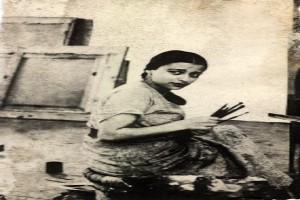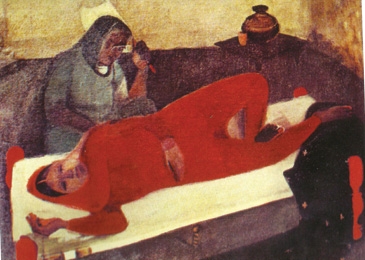
Amrita Sher-Gil in her studio in Shimla, 1937
Feature: Amrita an enigma – 3
 By Amit Srivastava
By Amit Srivastava
Amrita Sher-Gil had a deep empathy with her Indian subjects. Her brushstrokes brought out the loneliness, hopelessness of the poor in India, a subject that was hitherto untouched by the painters before her. While others focused on the mythology and classical themes, she took upon herself to search for the predicament and aspirations of the underprivileged. One of the most exemplary aspect of her painting, that elevated her as one of the finest painters of India, is the soulful depiction of women. While Raja Ravi Varma captured women in all the grace, beauty, charm and all the aesthetics, Amrita’s special quality has been the way she reaches out to the soul of the women she is trying to paint. The images created by her are haunting depictions and established her as a tour de force of modern art. Her brushstrokes fill up the canvas with their innermost desires, hopes and loneliness. She has painted women in various moods and activities – going to market, waiting for someone, or just bonding with other women, the salient feature of all characters is the silent resolve they display. They come off as individuals in the midst of difficult and hopeless situations but ready to face them with resolve.
Her paintings of group of women are almost always layered with nuances. They examine their relationships with each other, between the oppressor and the oppressed and also with the society at large. In a way all of these are a reflection of Amrita’s own fight to carve out an identity of herself. The lonely fight of an artist in search for true art so beautifully blends in her work in the form of the silent fight her subjects wage against poverty and gender injustice. She understands the loneliness of subjects well since they mirrored her own. In fact these strong portrayals of women’s inner personality make Amrita’s work stand out from others. .
While the sights and sounds of India made her happy, the poverty of the people evoked a deep empathy in her.

Both Raja Ravi Varma and Amrita used Western tools to depict Indian Women but there is a huge difference in the way they depicted women in their painting. While Ravi Varma has chosen to depict fair skinned women, decked up with jewels. His depictions of womenfolk is very often erotic even though couched in mythological themes. Amrita’s portrayal of women is vastly different. Her paintings are a window to the silent, powerful, unfulfilled desires of their female subjects. Their sexuality grips the viewer with its honest, unabashed representation of the human condition. Her motive is not to depict the beauty of women folk but hers are beautiful paintings of women in various moods and situations.
Looking at the works shown above we see that Ravi Varma’s reclining woman has been set in luxurious setting with an open book and her gaze towards viewer looking seductively. Amrita’s Reclining woman is entirely different. In this painting, Amrita has filled her woman with full-red garments and dark complexion, which was rare at that time. This is more like a silent peep into the intimate world of women mostly ignored in the outer of world of men. The different shades of ochre and red add to the sense of restlessness in the woman’s figure.
THE CHANGING COLOUR PALLETTES
Amrita’s paintings display an exceptional colour palette filled with unbridled and bold colours. Amrita’s shifting obsessions with a particular set of colours during different phases of her life makes an interesting study. Her disenchantment with the dull colours used by artists in Europe, was evident quite early in her career during her Paris days. She has written some eloquent letters on a variety of topics ranging from art to personal relationships. In one of the letters written in 1933 from Shimla she writes:
“Here everything is natural. In Europe the greyness and coldness of big cities I was never able to enjoy. I was born with a certain thirst for colours and in Europe the colours are pale. Because we cannot paint in the west as we can paint in the East. The colour of the White Man is different from that of a Hindu and the sunshine changes the light.”
She always felt a strong connection with her use of colours. It took her a while to work and get skilled in forms. There was a phase when blue and green were her favorite choice. This was during the Paris years. She wrote:
“I am passionately and intensely involved with the beauty of colours I am working with. I have periods when I use certain colour combinations and however must I try with other colours during this period yet I am not able to use other colours. Right now even if I try other colour combinations, the blue and green comes back.”
In 1937 she painted the south Indian Trilogy. Of these, ‘The Bride’s Toilet’ and Brahmcharis revel in colour. The deep burnt red of the earth and the insensate blind the viewer like an afternoon sun.
– (to continue)






Brawo tak trzymać. Widać, że dbasz o merytoryczne wpisy na Twoim blogu, Dzięki i zapraszam do siebie…(Bravo keep it up. You can see that you take care of substantive entries on your blog, Thanks and invite you to yourself …)
There were some comments on my blog on Feb 18th 2022 which I did not see earlier. Just today i saw. Thanks for your encouraging thoughts.
We wanted to share with you the best way impressed I’m with your service and product.
Wonderful beat ! I would like to apprentice even as you amend your site,
how could i subscribe for a weblog site?
The account helped me a appropriate deal.
I have been tiny bit acquainted of this your broadcast offered brilliant transparent concept.